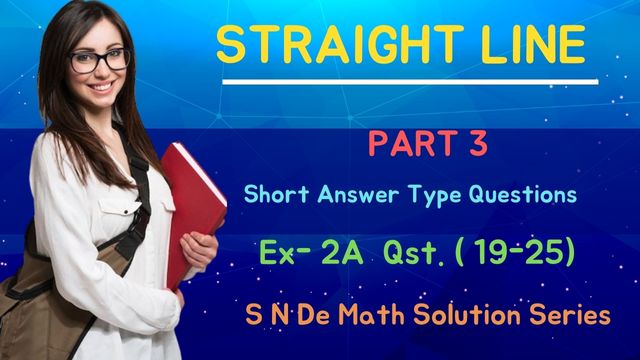In the previous article, we discussed 9 short ans type questions of Short Answer Type Questions of Straight Line Chapter of Chhaya Mathematics, Class 11. In this article, we have solved few more.

19.A ray of light start from ![]() , reflect on
, reflect on ![]() axis at
axis at ![]() and hence passing through
and hence passing through ![]() find the co-ordinates of
find the co-ordinates of ![]()
Solution.

According to the problem, ![]() lies on
lies on ![]() axis. Let the co-ordinates of
axis. Let the co-ordinates of ![]() be
be ![]()
![]() and
and
![Rendered by QuickLaTeX.com \tan(\pi-\theta)=\frac{2-0}{1-x} \\ \text{or,}~~-\tan\theta=\frac{2}{1-x} \\ \text{or,}~~-\frac{3}{5-x}=\frac{2}{1-x}~~[\text{By (1)}] \\ \text{or,}~~ -3+3x=10-2x \\ \text{or,}~~5x=13 \\ \text{or,}~~x=\frac{13}{5}](https://examhoop.com/wp-content/ql-cache/quicklatex.com-80a26a41329b52b9d4156f7ef633f16c_l3.png)
Hence, ![]()
20. Find the equation to the straight lines which are at a distance of ![]() unit from the origin and which pass through the point of intersection of the lines
unit from the origin and which pass through the point of intersection of the lines ![]() and
and ![]()
Solution.
We have the equations of straight lines ![]() and
and ![]()
Solving ![]() and
and ![]() we get,
we get, ![]()
Now, the straight lines passing through the point of intersection of the given lines must pass through the point ![]()
Any straight line through the point ![]() can be written as
can be written as ![]() where
where ![]() is the slope of the straight line.
is the slope of the straight line.
Equation ![]() can be written as
can be written as ![]()
Perpendicular distance from origin to the straight line ![]() is
is ![]()
According to the problem,

For ![]() the equation of straight line
the equation of straight line ![]()
For ![]() the equation of straight line
the equation of straight line
![]()
21. Find the equation of the straight line through the point of intersection of the lines ![]() and
and ![]() and through the centroid of the triangle whose vertices are
and through the centroid of the triangle whose vertices are ![]() and
and ![]()
Solution.
The equation of the straight line through the point of intersection of the lines ![]() and
and ![]() is
is
![]()
Now, centroid of the triangle whose vertices are ![]() and
and ![]() is
is ![]()
Since the straight line ![]() passes through the point
passes through the point ![]() , so
, so

So, putting the value of ![]() , we get the required equation of the straight line which is
, we get the required equation of the straight line which is

22. Examine whether the straight lines ![]() and
and ![]() are concurrent or not.
are concurrent or not.
Solution.
Solving ![]() we get,
we get, ![]() Putting these values of
Putting these values of ![]() in the straight line
in the straight line ![]() we get,
we get,

So, ![]() does not satisfy the equation of the third straight line and hence we can conclude that the straight lines
does not satisfy the equation of the third straight line and hence we can conclude that the straight lines ![]() and
and ![]() are not concurrent.
are not concurrent.
23. For what value of ![]() the three straight lines
the three straight lines ![]() and
and ![]() pass through the same point ?
pass through the same point ?
Solution.
Solving ![]() we get,
we get, ![]()
Since the three straight lines pass through the same point, so
the third straight line passes through the point ![]()

24. If the straight lines ![]() and
and ![]() are concurrent, show that the points
are concurrent, show that the points ![]() and
and ![]() are collinear.
are collinear.
Solution.
Since the straight lines ![]() and
and ![]() are concurrent, suppose that the common point is
are concurrent, suppose that the common point is ![]()
![]()
From ![]() we can say that the general solution of
we can say that the general solution of ![]() is
is ![]() and
and ![]()
Again, ![]() represents a straight line on which the points
represents a straight line on which the points ![]() lie.
lie.
Hence, the points ![]() and
and ![]() are collinear.
are collinear.
25. Show that the equation of the straight line through ![]() and through the point of intersection of the lines
and through the point of intersection of the lines ![]() and
and ![]() is
is
![]()
Solution.
Equation of any straight line passing through the point of intersection of intersection of the lines ![]() and
and ![]() is
is
![]()
Now, if the straight line ![]() passes through the point
passes through the point ![]() then
then
![]()
Now, putting the value of ![]() in
in ![]() we get
we get

Read More :
Straight Line | Part-4 |Ex-2A
Straight Line | Part-5 |Ex-2A
Straight Line | Part-6 |Ex-2A
Straight Line | Part-7 |Ex-2A